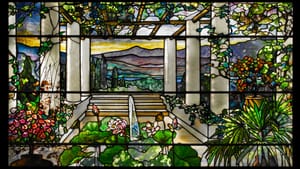Stay in the Loop
BSR publishes on a weekly schedule, with an email newsletter every Wednesday and Thursday morning. There’s no paywall, and subscribing is always free.
The pursuit of beauty
The Delaware Art Museum presents Louis Comfort Tiffany: Treasures from the Driehaus Collection

Today, “Tiffany” is synonymous with fine jewelry and home goods, teal blue gift boxes, and a flagship store on New York’s Fifth Avenue. But at the turn of the 20th century, this company was at the forefront of innovative American artistry and design. On view at the Delaware Art Museum is a glowing exhibition of the iconic craftsmanship that cemented that reputation: Louis Comfort Tiffany: Treasures from the Driehaus Collection.
The art of imperfection
Louis Comfort Tiffany (1848-1933) was the American artist and designer most associated with the Art Nouveau and Aesthetic movements, and his lifelong goal was “the pursuit of beauty.” The son of New York jewelry designer William Charles Tiffany, he was educated in West Chester, Pennsylvania, and Perth Amboy, New Jersey, and began his illustrious career as design director of his father’s firm. But he also trained as a painter, studying with noted landscape artists George Inness and Samuel Colman, and after working at several stained-glass houses in Brooklyn, in 1885, he broke from the family business to establish a company that would become the legendary Tiffany Studios.
Tiffany worked in nearly all media available to artists and designers of his time: glass, ceramic, metalwork, jewelry, and painting. And from the start, he explored and developed unique processes that set his work apart. He first used jelly jars and bottles to utilize their impurities. Unable to convince fine glassmakers to leave in the flaws, he began creating his own glass in a Queens, New York factory, where he embedded color (rather than placing it over clear panes) and developed “confetti glass” with small floating pieces. He called all his glass favrile (French for “handmade”) and trademarked the term.
Glowing objects
At its height, Tiffany Studios employed more than 300 artists and artisans, and many of its leading designers were women like Clara Driscoll and Lydia Emmet Field. This exhibition features 60 of the most remarkable pieces from the huge Tiffany holdings (more than 1,000 works) of Chicago’s Richard H. Driehaus Collection. As anticipated, here are the stunning windows, famous lamps, and striking vessels and vases—blown, folded, colored, or faceted—that poured forth from the studios. But there’s also a surprise: the company’s innovative metalwork. Subdued gallery lighting and beautiful walnut-toned casework create a peaceful setting that allows for relaxed and intimate viewing of these glowing objects.
There were two iterations of Tiffany’s remarkable lamps: some could be purchased with both base and shade, while others were designed for buyers to mix and match. Here are exquisite lamps both familiar (Peony and Wisteria) and unfamiliar, like Fish and Waves with its unique blown globe. The lamps have vents called “heat caps,” some of pierced metal that throw shadows on the ceiling. It’s especially revelatory to look closely at their bases, beautiful works of art equal to their glass shades.

Windows and interiors
Tiffany Studios also specialized in interior design, and among its many major installations (which included mosaics) were the White House, Mark Twain’s Connecticut residence, and Tiffany’s own home on Long Island, destroyed by fire in 1957. These interiors often featured that spectacular metalwork. On view here are a massive set of brass andirons (fit for any Gilded Age mansion) and a chainmail-like fireplace screen with 700 tiny tesserae (tiles) of opalescent glass that would glitter as the fire glowed behind it.
And of course, the company created those magnificent stained-glass windows that adorn buildings worldwide. Installing them in your church or institution marked you as a tastemaker and a cutting-edge arts patron. The windows here may be smaller, but they are still staggeringly beautiful—landscapes with opalescent glass vistas and intricate medallion designs (one almost Moorish) studded with jewel-like three-dimensional pieces.
The museum has included one of its own prize holdings: a window from the home of Samuel Bancroft. Titled Spring and Autumn, its two portrait panels were painted by Lydia Emmet Field for the 1893 Chicago World’s Fair. Bancroft purchased them there and then commissioned the intricate briar-rose border to complement Edward Burne-Jones’s The Council Chamber, installed in his Delaware mansion and now on view in the museum’s British Pre-Raphaelite collection.
A respite from the 21st century
Louis Comfort Tiffany sits seamlessly alongside the Pre-Raphaelite collection and museum holdings from the Arts & Crafts period, both movements which influenced Tiffany with their focus on nature, attention to details, and pride in craftsmanship. There are free exhibition tours on Sundays (reservations recommended, as they fill up), and on April 29, 2022, Metropolitan Museum of Art curator Alice Cooney Frelinghuysen will lecture on Tiffany glass. There is a luscious companion volume for sale in the museum shop, and an independent bookstore with a selection of volumes about the Gilded Age.
Exhibition curator Heather Campbell Coyle invites visitors to take a respite from the 21st century and “imagine elegant Gilded Age interiors while enjoying the glorious color and exquisite craftsmanship” of these exceptional Tiffany creations, a visit both soothing and inspiring.
What, When, Where
Louis Comfort Tiffany: Treasures from the Driehaus Collection. Through June 5, 2022 at the Delaware Art Museum, 2301 Kentmere Parkway, Wilmington, DE. $14 (students $7; youth $6; kids under 6 free). (302) 571-9590 or delart.org.
Masks are not required inside the museum, but visitors are required to wear masks in the auditorium, on gallery tours, on school tours, and in studio classes. Check museum website for updates.
Accessibility
The museum and outdoor Copeland Sculpture Garden are wheelchair accessible with free parking and barrier-free entrance. Wheelchairs are available; personal care are attendants admitted free.
Sign up for our newsletter
All of the week's new articles, all in one place. Sign up for the free weekly BSR newsletters, and don't miss a conversation.

 Gail Obenreder
Gail Obenreder